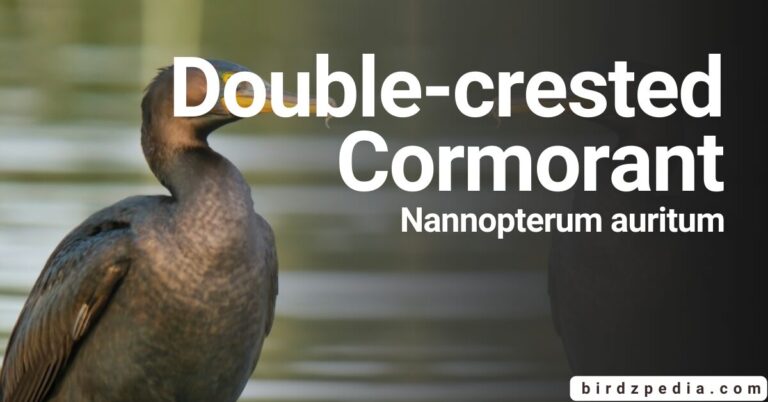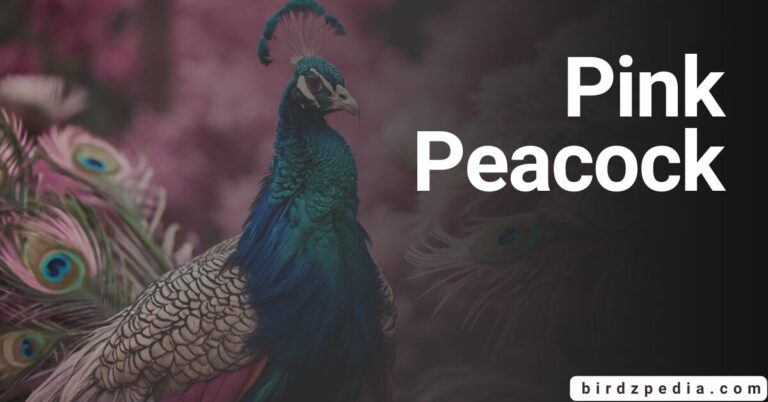Red-Naped Ibis [Pseudibis papillosa]: Facts, Sounds, Habitat
Scientific Classification
| Kingdom | Phylum | Class | Order | Family | Genus | Species |
|---|---|---|---|---|---|---|
| Animalia | Chordata | Aves | Pelecaniformes | Threskiornithidae | Pseudibis | Pseudibis papillosa |
Red-Naped Ibis
They are widely recognized as the Indian black ibis, black ibis, or red-naped ibis. It is a unique species of ibis that inhabits the plains of the Indian Subcontinent. Distinguished from other ibises in the area, this species is notably self-sufficient away from water sources and is often
observed in dry fields, far from water. These ibises are easily identified by their dark-colored plumage, which has a characteristic white patch on the shoulder. Usually, they wander in loosely formed groups. One characteristic that sets them apart is their dark, bare head, which is adorned
with a cluster of red warty skin on the crown and neck. This species is well recognized for its loud activity, especially during the breeding season when it emits a loud call. It shows a penchant for high places to build nests, frequently choosing the tops of big trees or palms.
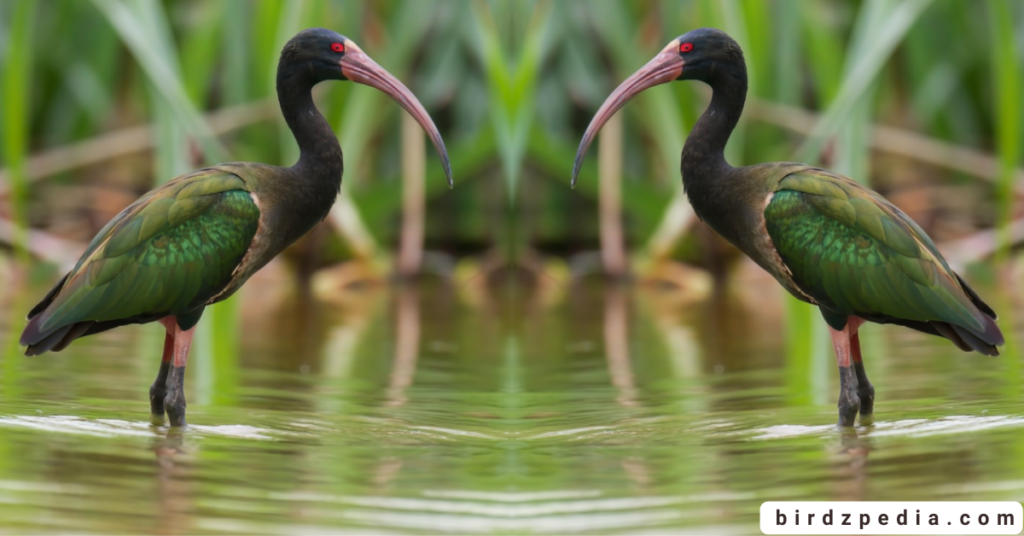
Summary
- Region: Found in the plains of the Indian Subcontinent
- Distinctive Features:
- Dark plumage with a white shoulder patch
- Bare, dark head adorned with crimson red warty skin on crown and nape
- Behavior:
- Independent of water sources, often seen in dry fields
- Travels in loose flocks
- Emitting loud calls, particularly during breeding
- Habitat:
- Nests on top of large trees or palms
- Description:
- Distinctive medium-sized bird with dark plumage and a white shoulder patch.
- Notable bare, dark head adorned with crimson red warty skin on the crown and nape.
- Loud calls and noisy behavior, especially during breeding.
- Food and Foraging:
- Forages on margins of wetlands, showing versatility in diet.
- Not very dependent on water; adapted to varied foraging environments.
- Breeding:
- Constructs nests on the tops of large trees or palms.
- Noisy behavior and distinct vocalizations, particularly during the breeding season.
- Status and Conservation:
- Conservation status: Least Concern (Population decreasing).
- Common breeding resident in Haryana, Punjab, and the Gangetic plain.
- Extensive range but population trends indicate conservation attention is needed.
Description
The large black bird known as the Pseudibis papillosa has long legs and a bill that arches elegantly. Its neck and torso are a non-reflective earthy brown color, and its striking black wing feathers and shiny blue-green tail are a feature. This bird is easily identified by its striking white patch on the
shoulders. In addition, the featherless head, which is more prominent in older birds, has a characteristic triangular caruncle with a bright red, warty appearance. The traits of the two sexes are similar, and fledglings have the exposed head and crown and initially have browner
plumage. The iris radiates a vibrant orange-red, and as the breeding season unfolds, bills and legs adopt a reddish tint. The toes, possessing a fringed membrane and a slight webbing at the base, contribute to the unique features of this captivating bird.
They are calm birds of prey who break their stillness at dawn and dusk with loud, shrieking brays. This behavior is especially noticeable during the breeding season. Distinctions emerge, yet there’s room for confusion with the glossy ibis up close. The red-naped ibis differs
from the glossy ibis in that it is smaller, gregarious, prefers marshy areas to be its home, and has white wings. The red-naped ibis is easily distinguished from the glossy ibis by its uncovered head, which sets it apart from the latter’s fully feathered head.
Taxonomy
When Temminck assigned the scientific designation for this species in 1824, he initially included it in the genus Ibis. Later, Reichenbach made the distinction between the genus Inocotis and the genus Ibis; this separation has been upheld in other significant publications, including the Fauna
of British India. Although Hodgson initially put it in the genus Pseudibis, it was moved to this genus by precedence based on the concept of primacy. They (P. papillosa) was thought to comprise the white-shouldered ibis until P. papillosa davisoni was recognized as a
subspecies in 1970.Currently, these are acknowledged as distinct species that vary from one another genetically and physically. The red tubercle patch on the back of the crown is the primary feature that distinguishes P. papillosa from P. davisoni. Additionally, the mature P. davisoni has a
light blue, bare middle hindcrown that extends up to the upper hindneck, forming a collar that is fully enclosed around the upper neck. In contrast, the mature P. papillosa has a thin, bright red mid-crown that overlaps the hindcrown.
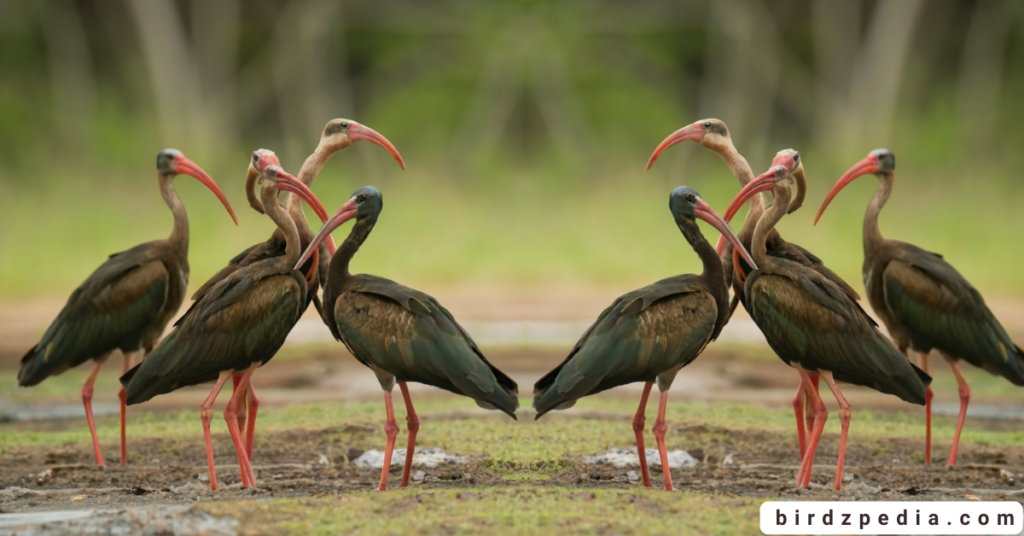
Distribution and Habitat
A significant population of Pseudibis papillosa inhabits the vast plains of the Indian Subcontinent. They are incredibly adaptable, as evidenced by their prevalence in cultivated farmlands, rivers, lakes, and marshes, among other different settings. The fact that this gregarious bird is frequently
seen foraging in small groups around wetlands highlights how social it is. Remarkably, it becomes a regular breeding resident in important areas like Punjab, Haryana, and the Gangetic plain, spreading its range to southern India. But it is conspicuously missing from the region’s
forested parts, the drier southeast of the peninsula, and Sri Lanka. The Pseudibis papillosa is a daytime forager that participates in a variety of activities. At night, it gathers in groups to roost on trees or islands.
Food and Foraging
The food of the red-naped ibis is omnivorous; it includes carrion, insects, frogs, small vertebrates, and cereals. While they usually feed on stubbly fields and dry open spaces with disturbed insects, they may often accompany egrets in land tillage to hunt exposed beetle grubs and disturbed
insects. They stroll and investigate the soft ground using tactile-feeding strategies. They rarely wade in the water, but when they do, they have been seen looking for frogs hiding in crab holes. There are times when they eat at trash dumps. During dry spells, the red-naped ibis consumes
carrion and insect larvae as essential food sources. They are notable for having a varied diet because they eat a variety of crops, but they have a special preference for groundnuts. In British India, indigo planters valued this dietary flexibility because they thought ibises helped manage
cricket populations in their fields. These ibises travel in unison to and from their designated roost place during communal roosting, frequently forming the unmistakable and characteristic “V” shape.
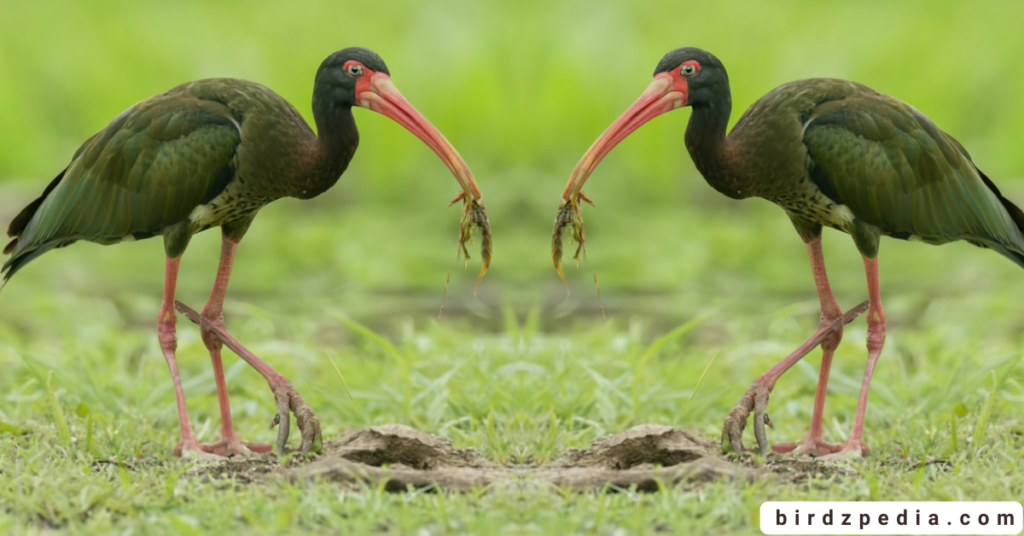
Breeding
- Pseudibis papillosa hardly never nest in mixed-species heronries; instead, they usually nest alone.
- Small colonies, consisting of three to five pairs in a single tree, may occur.
- The breeding season, which often occurs before the monsoons, lasts from March to October.
- Males trumpet from the nest site as females beg for food from them at foraging grounds during pair-bonding.
- Nests are big stick platforms that are 10-15 cm deep and 35-60 cm in diameter. They are frequently constructed on top of abandoned vulture and kite nests.
- In Gujarat, nests are built 6–12 meters high on peepal or banyan trees, and occasionally on powerline pylons. The nests are lightly coated with straw.
Couples primarily copulate while seated in trees. - Eggs (2–4) have faint reddish blotches and scanty flecks of bluish green color.
- The eggs are incubated by both the male and the female, hatching after 33 days.
Parasites
The small intestine of them contains the nematode Belanisakis ibidis, and the bird lice that live there are peculiar to the ibis genus, specifically Ibdidoecus dennelli. Furthermore, it has been shown that the Digenea flatworm Patagifer chandrapuri is present in the intestines of
specimens from Allahabad. A trematode known as Diplostomum ardeiformium has been observed in them hosts kept in captivity. Moreover, Eimeria-like protozoan parasites have been discovered.
Threats
Table outlining the threats faced by them:
| Threats | Description |
|---|---|
| Habitat Loss | Destruction and degradation of natural habitats. |
| Hunting | Targeted hunting of the Pseudibis papillosa by humans. |
| Agricultural Activities | Agricultural expansion impacting foraging and nesting areas. |
| Pollution | Contamination of water sources and food with pollutants. |
| Climate Change | Altered weather patterns affecting breeding and foraging. |
| Nest Disturbance | Human interference leading to disturbance of nesting sites. |
| Capture for Trade | Illegal capture for trade in the exotic pet market. |
| Disease | Susceptibility to diseases impacting population health. |

In culture
The “anril” bird, so named because of its curved bill, is mentioned in Tamil Sangam literature as calling from atop palmyra palms. Madhaviah Krishnan recognized it as the black ibis, rejecting theories based on its behavior that suggested it was a sarus crane. Sangam poetry describes the
birds’ lifelong breeding behavior and pair-walking style, which frequently confuses them with the sarus crane, despite the latter being absent from southern India. Names for this species such as “kālakaṇṭak” are found in Sanskrit literature. Jerdon has documented local names such
“karankal” and “nella kankanam” in Telugu and “buza” or “kālā buza” in Hindi. Sportsmen in British India referred to it as the “king curlew,” “king ibis,” or “black curlew,” viewing it as a delicacy and a pastime in which falconers competed in races and made airborne escapes from other falcons.
Lifespan
In the wild, they lives for approximately 15 to 20 years on average. However, a number of variables, including as the environment, predators, illnesses, and dangers from humans, might affect an individual’s real longevity. These birds might live longer in captivity if they are given the proper care and security.
Status and Conservation
Hunting and habitat degradation are the main causes of the Pseudibis papillosa notable decline in Pakistan. By contrast, in India, where farmers have long tolerated their existence, the species is largely unaffected. Although they are thought to be safe in the wild, certain zoos—such as
Frankfurt and Singapore’s Jurong Park—have had success with captive breeding. A notable example of this species’ longevity in captivity is the 30-year lifespan of an individual at Berlin Zoo.

Common Names in Different Languages
| Language | Common Name for Red-naped Ibis |
|---|---|
| English | Red-naped Ibis |
| Latin | Pseudibis papillosa |
| Hindi | सुल्तानपुरी (Sultanpuri) |
| Spanish | Ibis de Garganta Roja |
| French | Ibis à nuque rouge |
| German | Rotscheitelibis |
| Chinese | 红枕朱鹮 (Hóngzhěn Zhūxiàn) |
| Japanese | アカボシシラサギ (Akaboshi Shirasagi) |
| Russian | Красношейная ибис (Krasnosheynaya Ibis) |
| Arabic | أبو مرعش الحمراء (Abu Mar’ash Al-Hamra’) |
FAQs
What is the Red-naped Ibis?
One species of bird in the ibis family is the Pseudibis papillosa. It is easily recognized by the characteristic red spot on the nape of its neck.
2. Where is the natural habitat of their?
Primarily found in South Asia, these ibises live in a variety of wetlands, marshes, and agricultural areas in nations including Bangladesh, India, Nepal, and Pakistan.
3. What does they look like?
The plumage of adult is primarily black, with a white patch on the wings. The brilliant red patch on the back of their neck, which is more noticeable during the breeding season, is their most distinctive trait.
4. What is the diet of the Red-naped Ibis?
Being omnivores, they consume a wide range of foods, such as aquatic vegetation, insects, and small animals and crustaceans. Shallow water is their usual feeding area.
5. How does the Pseudibis papillosa reproduce?
It is normally during the monsoon season that these ibises reproduce. They frequently construct their colonies of nests in trees or reed beds next to sources of water. Two to four eggs are typically laid by the female, and both parents assist with the incubation and care of the hatchlings.
6. Is they considered a threatened species?
In January 2022, when I last updated my information, they were not regarded as a threatened species worldwide. Their populations, however, may be impacted by specific stressors such habitat loss and degradation.
7. Are Pseudibis papillosa migratory?
It is unknown if they migrate over great distances. They are mostly sedentary, though seasonal variations and the availability of water may have an impact on their travels.
8. How does they contribute to its ecosystem?
Especially in agricultural areas, these ibises help regulate bug populations. Their foraging practices support the equilibrium of nearby ecosystems.
9. Can the Pseudibis papillosa be kept as a pet?
The majority of nations forbid and strongly advise against keeping wild birds as pets, such as they are. Instead, the goal of conservation initiatives is to protect their natural ecosystems.
10. What conservation measures are in place for the Pseudibis papillosa?
Protection of habitat, population monitoring, and education about the value of wetland conservation are all part of conservation efforts. Organizations both domestically and globally strive to protect them and its environment.


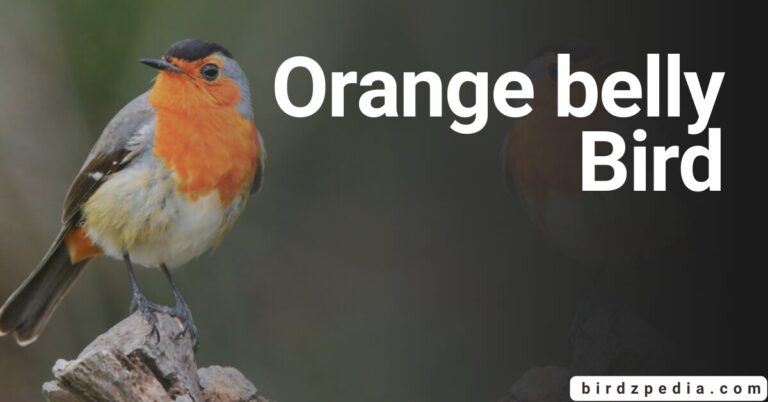

![Little pied cormorant[Microcarbo melanoleucos]: Fascinating Details](https://birdzpedia.com/wp-content/uploads/2024/01/Little-pied-cormorant-768x402.jpg)
